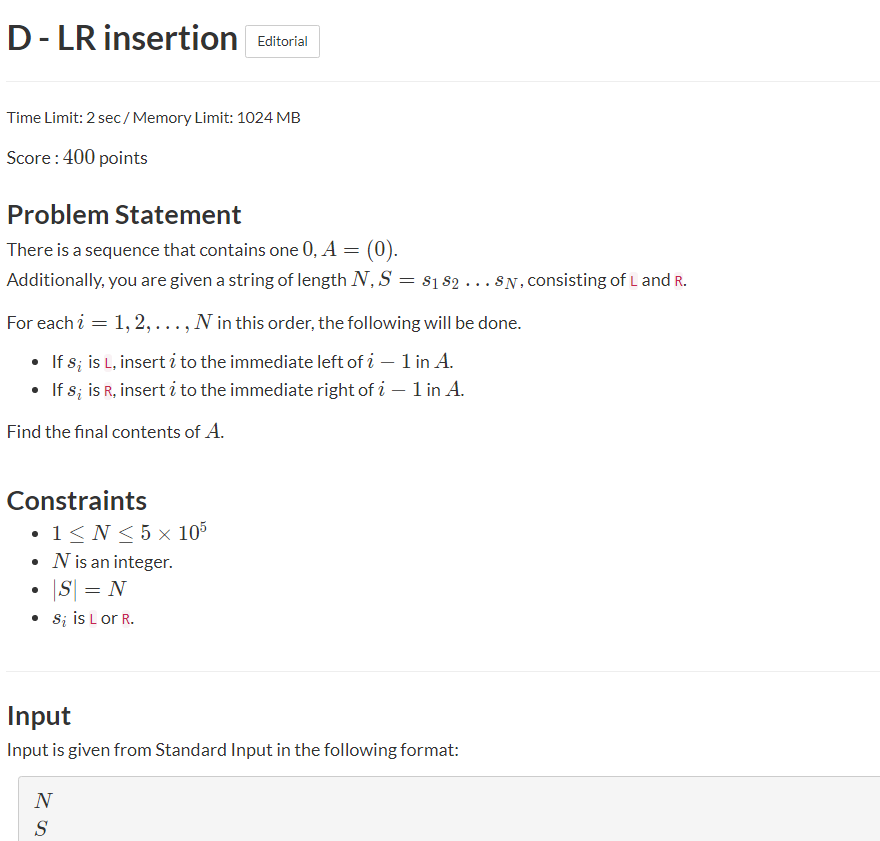A - Not Overflow
Question meaning: judge whether an input number is between the 31st power of - 2 and the 31st power of - 1
Idea: note that the input range is actually to input a long long number and find out whether an input number is in the int range.
Simple questions can be judged directly
#include<bits/stdc++.h>
using namespace std;
int main()
{
long long ans=0;
cin>>ans;
if(ans>=(-1)*quickpow(2,31)&&ans<=quickpow(2,31)-1)
{
scYes;
}
else
{
scNo;
}
return 0;
}
B - Matrix Transposition
Input a matrix and output the inverse of the matrix.
Idea: at first, I wanted to do it directly. I used to use array to simulate, but I found that the boundary would reach 1e5, and the classic opening was not enough, so I used vector array to simulate the output backwards.
#include<bits/stds++.h>
using namespace std;
const int maxn=1e5+100;
vector<int >a[maxn];
int main()
{
int n,i,j,m;
cin>>n>>m;
for(i=0;i<n;i++)
{
for(j=0;j<m;j++)
{
int d1;
cin>>d1;
a[i].push_back(d1);
}
}
for(i=0;i<m;i++)
{
for(j=0;j<n;j++)
{
cout<<a[j][i]<<" ";
}
cout<<endl;
}
return 0;
}
C - kasaka
Question meaning: if you enter a string, you can only add a from the front to find out whether it is a complete palindrome string after adding.
Idea: at the beginning, I didn't see the scope clearly. I wanted to delete the character a from the front and back respectively, and then delete it through the position of the marking machine. I don't know what's wrong with this idea. I kept wa. After careful consideration, I found that it still needs to judge the two situations of ba and ab, and then it passed. In fact, it is judged that the number of broken leading a is greater than the current leading a, which is still too small.
#include<bits/stdc++.h>
using namespace std;
int main()
{
string s1,s2;
int flag1=0,flag2=0;
cin>>s1;
for(int i=0;i<s1.length()/2;i++)
{
if(s1[i]!=s1[s1.length()-i-1])
{
flag1=1;
}
}
if(flag1==0)
{
scYes
}
else
{
int d1=s1.length();
int d2=s1.length()/2;
int i,f1=s1.length(),f2=0;
int cnt1=0,cnt2=0;
for(i=d1-1;i>0;i--)
{
if(s1[i]=='a') {cnt1++;continue;}
else break;
}
f2=i;
for(i=0;i<d1;i++)
{
if(s1[i]=='a') {cnt2++;continue;}
else break;
}
f1=i;
if(cnt2>=cnt1)
{
scNo;
return 0;
}
for(int i=f1;i<=f2;i++)
{
s2+=s1[i];
}
int ff=0;
for(int i=0;i<s2.length()/2;i++)
{
if(s2[i]!=s2[s2.length()-i-1])
{
ff=1;
}
}
if(ff==0)
{
scYes
}
else
{
scNo;
}
}
return 0;
}
D - LR insertion
Give you n+1 numbers, and then follow the requirements of the string it gives. For example, if you give you a string that is
"LR", then the first step is to add a 1 to the left of 0, and then add a 2 from the right of 1, so the final result is 120
Idea: at first, I wanted to do it with data structures such as queues and stacks. It seemed that they couldn't solve this problem. Then I forgot about the linked list. As a result, I found that they actually said it was a double ended queue??? WTF, after thinking for a long time, I found it impossible. As a result, the first step of looking at other people's code reverses the string, so here we need a reverse idea. If you reverse all operations, you will find that this is a naked double ended queue, but I still didn't find out how they came up with it...

#include<bits/stdc++.h>
using namespace std;
int main()
{
int n,i,j,t;
string s1;
deque<int >d1;
cin>>n>>s1;
reverse(s1.begin(),s1.end());
d1.push_back(n);
n-=1;
for(i=0;i<s1.length();i++)
{
if(s1[i]=='L')
{
d1.push_front(n);
}
else
{
d1.push_back(n);
}
n-=1;
}
int length=d1.size();
reverse(d1.begin(),d1.end());
for(i=0;i<length;i++)
{
cout<<d1.front()<<" ";
d1.pop_front();
}
return 0;
}